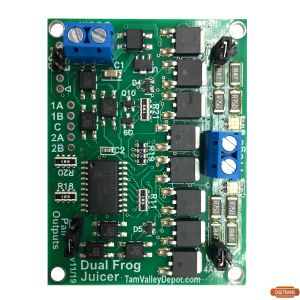All ZIMO MS decoders are functionally largely identical.
GENERAL INFORMATION:
- DCC addresses 1 – 10239, consist addresses 1 – 9999, MM addresses 1-80,
functions F0-F28
- 14, 28 or 128 external speed steps, 256 or 1024 internal steps
- Programming CVs in “Service Mode” (on the programming tracks) and in “Operational Mode” (with RailCom for feedback and acknowledgements), using mfx, if available
- Driving operation without interruptions (without decoder reset or restart) after losing contact to the rails for 1 or 2 seconds (even without external stay-alive capacitors)
- Automatic continued operation if the wheel/track contact is interrupted until the supply is restored (if sufficient energy storage - "Stay alive" - is available in locomotive; see section "ENERGY STORAGE, below)").
- DC and AC analog operation, the latter including direction reversal through Märklin-typical overvoltage pulse (up to 35 V)
- Updateable software: new software versions are loaded into the decoder without opening the loco, via flash drive with the decoder updating and sound loading device MXULF/A or with the central controller MX31ZL, or directly from the computer via ZSP (ZIMO Sound Programmer) and MXULF or MX10 (planned)
SECURITY:
- Overcurrent protection for all outputs, protection against overtemperature, for details see “total current”
- Resilience 35 V bis 50 V.
- Protection against high voltage peaks due to the inductivity of the motor by suppressor diodes
MOTOR CONTROL:
- Silent high frequency motor control, eligible between 20 kHz and 40 kHz
- Suited for all DC motors and coreless motors (Faulhaber, Maxxon) with additional diodes also AC motors
- ZIMO motor control with self-optimization and various possibilities for manual adjustment
- Speed characteristic curve either there-point or freely programmable in 28 steps (according to the standard)
- Alternative “East-West” direction control and feedback in combination with digital central station MX10 or controller MX32
- Km/h control (each speed step equals ½ km/h, 1 km/h, 2 km/h) as alternative to the traditional speed step control
- Adjustable procedure to level the idle run when changing direction to avoid start-up jerks
- ZIMO acceleration adjustments (“standardized”, additionally “exponential” for smooth driving off/stopping, “adaptive” against start-up jerk)
- Functions of shunting-key (half-speed, reduction or turn-off of the acceleration/deceleration times, eligibly F3, F4 or MAN)
- Automatic continuance when interrupting the rail/track-contact until the power supply is restored (in case of a stay-alive capacitor)
FUNCTIONS AND FUNCTION OUTPUTS:
- Full NMRA function mapping for F0-F12, as well as ZIMO expansions (direction-dependent allocation, etc.)
- Dimming, flashing, American (Mars, Ditch, Strobe, …) and other lighting effects (Soft Start, braking light, flickering, automatic time-off, etc.)
- Switching high beam/low beam per function key, unilateral light suppression, configuration of smoke generators, etc.
- ZIMO Swiss Mapping for complex lighting situations depending on different function keys with individual allocation of lighting effects (dimming, flashing, …)
- ZIMO Input Mapping, especially for the user to exchange function keys without actually changing the configuration
- Time-limited coupling control for Krois and Roco and automatic uncoupling (automatically moving in slightly, uncoupling and moving away)
- SUSI interface on the connector or as solder pads, for large scale decoders with 4-pin SUSI connector
- Additionally to “normal” function outputs, the MS decoders also have logic level outputs which can be used as connections for servos or as transistors for traditional consumers (LEDs, etc.)
- All decoders have a servo drive, those for gouge N to H0 as a secondary function of the SUSI connections, large scale decoders with full 3-pin servo connections including 5 V supply.
Servo configuration with special CVs for end and middle positions, rotation speed, function assignment.
TRAIN PROTECTION SYSTEM AND FEEDBACK
- Braking distances DC, ABC (stopping because of asymmetrical DCC signal), “Märklin braking distance”
- ZIMO “signal dependent train control” (HLU) with speed limits in 7 steps, from “Full speed” to "Halt/stop": F, FL, L(ow speed), LU, U(ltra low speed), UH, H.
- ZIMO loco number recognition in combination with ZIMO digital systems and track section modules MX9 (with new layouts or applications, especially with StEin or Roco feedback modules, the feedback works with RailCom)
- (from sw version 5.00 on) Constant braking distance in two variations: braking is either started immediately or later, depending on the current speed.
- RailCom: km/h feedback, reading and acknowledging CVs on the main, East-West feedback, Quality-of-Service, on-track search, RailCom address feedback,...
Many more features are planned in future software versions.
SOUND:
- Loading sound projects works similar to the MX decoders (with the same equipment), as well as loading new software (software update see above): With the decoder updating and sound loading device MXULF/A or with the central controller MX31ZL, or directly from the computer via ZSP (ZIMO Sound Programmer), or MX10 (planned)
- Alternatively fast sound loading (3 to 5 minutes instead of 30 to 1000 minutes) via SUSI interface (i.e. SUSI pins with a proprietary protocol)
- High-performance sound amplifier; in miniature sound decoders: 1 Watt for 8 Ω speakers; in HO sound decoders 3 Watt for 4 or 8 Ω speakers (also 2 in parallel); in large-scale decoders 10 Watt for 4 Ω or 8 Ω speakers (also in parallel) on the basis of 10 V.
- REAL 16 bit resolution covers the entire sound path: from the sound files stored in the flash memory, via the I²C-Bus (=Inter-IC-Sound) for stereo output, to the fully digital Class-D amplifier. ZIMO dispenses with the cheaper digital-to-analog conversion (with 10 or 14 bit) and amplifier with analog input (also called Class "D"), which are otherwise frequently used.
- Playback rate of 22 kHz (standard); but also (defined by the sound project) channels with 11 kHz (only with 8 bit) for simple noises, like announcements, and 44 kHz for maximum possible HiFi sound quality.
- MS decoders possess a sound flash of 128 Mbit, what provides playback time of 360 seconds (with 16 bits); with 8 bit sound and 11 kHz up to 1440 seconds are available.
New sound projects have a bit depth of 16 bits; but with the new hardware also sound projects with 8 bits sound better, due to the interpolation technique, which is available to ZIMO because of the high processing power of the microcontroller.
- Up to 16 sound channels can be reproduced simultaneously (e.g. steam shocks, air pump, whistle, ...) and can be distributed between two loudspeakers with "stereo decoders" (especially for large scale railways, but also planned for H0).
- Synchronisation of the steam chuffs either by connecting a cam sensor (mechanical, LED, Hall) or a virtual cam sensor, for sound as well as for controlling the smoke fan
- Sound collection as special form of a sound project: it contains sound samples and parameters for more than one loco type. Traditionally, ZIMO decoders come with the European steam/diesel collection with 5 sets of steam chuffs, 10 whistles, 2 bells, etc. You can choose between all of them in real time to create individual sounds.
- (from sw version 5.00 on) Dependencies on acceleration and load, a calibration run can be done automatically to adjust the load dependency
ONBOARD AND/OR EXTERNAL STAY-ALIVE CAPACITORS:
- Standard H0 sound decoder: connection option for external energy storage (electrolytic capacitors, tantals, gold caps with unlimited capacity and 15 V or 16 V dielectric strength, even if track voltage is higher, for example ZIMO SUPERCAP68 or GOLMRUND, GOLMLANG); thus continuing to run at full power despite contact interruption, avoiding light flickering and sound disturbances, compensating for energy loss through RailCom and HLU gaps.
- Next-Sound-Decoder: the internal tantalum energy storage on 5 V-basis can be extended by external tantals or goldcaps (with practically unlimited capacity 5 V of 2 x 2,7 V, e.g. ZIMO MINIGOLD); thus slow driving, reduction of light flickering and sound disturbances.
- For all decoders: with ZIMOs "StayAlive-Controller" (STACO1), or additional components like diodes and resistors, energy storage devices (mostly electrolytic capacitors, at the level of the driving voltage, preferably 25 V) can be connected to all decoders, even those without special precautions. The efficiency (energy yield) is lower than in the cases mentioned above.





